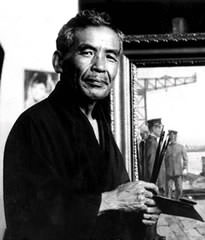Wada Eisaku
Wada Eisaku | |
|---|---|
| 和田英作 | |
 | |
| Born | December 23, 1874 |
| Died | January 3, 1959 (aged 84) |
| Nationality | Japanese |
| Known for | Painter |
| Movement | Yōga |
Wada Eisaku (和田英作, December 23, 1874 – January 3, 1959) was a Japanese painter and luminary of the
Biography
Born in what is now the city of
In 1896 Wada was involved, along with Kuroda and Kume, in the establishment of the
Returning to Japan, via Italy, also in 1903 he was appointed professor at his
Works
Representative works include his early Evening at the Ferry Crossing (1897), Thoughts of Home (1902), and Kodama (1902); his mid-life series of portraits; and his late Ue-no-Midō (1945) and Summer Clouds (1950).
Exhibitions
Dedicated retrospectives include the 2002 Wada Eisaku (和田英作展), at the Shizuoka Prefectural Museum of Art, 2007 Modern Western Master: Wada Eisaku (近代洋畫的巨匠 和田英作展), at the Kariya City Art Museum, 2014 Wada Eisaku (和田英作展), at the Kagoshima City Museum of Art, and 2016 Japanese Modern Yōga Master: Wada Eisaku (日本近代洋画の巨匠 和田英作展), again at the Kariya City Art Museum.[13]
Gallery
-
Hakuba-kai coterie in Paris in 1900; Wada Eisaku is the tall figure in the back row, with Okada Saburōsuke to his right; in the centre is Kuroda Seiki, with Kume Keiichirō to his left
-
Evening at the Ferry Crossing (1897) (University Art Museum, Tokyo University of the Arts); exhibited at the 2nd Hakuba-kai Exhibition and the Exposition Universelle
-
Girl Reading a Newspaper (1897) (University Art Museum, Tokyo University of the Arts); exhibited at the 7th Hakuba-kai Exhibition
-
Thoughts of Home (Portrait of a Japanese Lady) (1902) (University Art Museum, Tokyo University of the Arts); exhibited at the Salon and the 8th Hakuba-kai Exhibition
-
Old Woman (1908) (National Museum of Modern Art, Tokyo); exhibited at the 2nd Bunten
-
Red Fuji (1916) (Fujiyama Museum)
-
Portrait of Fukuzawa Yukichi (1920) (private collection)
-
Portrait of Taniguchi Goji (ja) (1925) (Kagoshima City Museum of Art)
-
Roses (c.1926) (Pola Museum of Art)
-
Girl in a Yellow Dress (1931) (Yamatane Museum); exhibited at the 12th Teiten
-
Ceremony for the Promulgation of the Constitution (1936) (Meiji Memorial Picture Gallery)
-
Ue-no-Midō (1945) (Kariya City Art Museum)
-
Landscape (1951) (Toyota Municipal Museum of Art)
See also
References
- ^ 和田英作 [Wada Eisaku] (in Japanese). Hiroshima Museum of Art. Retrieved July 18, 2020.
- ^ Weatherhill. pp. 96–98.
- ^ Tobunken. Retrieved July 18, 2020.
- ^ a b c d e f g h i j k l m n o p 和田英作 [Wada Eisaku] (in Japanese). IAI National Museum of Art 国立美術館. Retrieved July 18, 2020.
- ^ a b c d e f g h i j k 和田英作 [Wada Eisaku] (in Japanese). Kariya City Art Museum. Retrieved July 18, 2020.
- S2CID 191642343.
- ^ "Museum". Museum für Ostasiatische Kunst. Retrieved July 17, 2020.
- ^ action common download&item id=1405&item no=1&attribute id=22&file no=1 蝶の図像から蝶の図案へ: 和田英作の三井呉服店絵葉書からみる明治時代後期百貨店の広告イメージ 向後恵里子 - 明星大学研究紀要. 人文学部・日本文化学科, 2017,p77
- ^ 蝶の図像から蝶の図案へ: 和田英作の三井呉服店絵葉書からみる明治時代後期百貨店の広告イメージ 向後恵里子 - 明星大学研究紀要. 人文学部・日本文化学科, 2017,p77
- ^ 黒田清輝先生のスケッチブック
- ^ 和田英作 [Wada Eisaku] (in Japanese). Pola Museum of Art. Retrieved July 18, 2020.
- ^ a b こだま [Kodama] (in Japanese). Sen-oku Hakuko Kan. Retrieved July 18, 2020.
- ^ 和田英作 [Wada Eisaku] (in Japanese). Galerie Nichido 日動画廊. Retrieved July 18, 2020.; 日本近代洋画の巨匠 和田英作展 [Japanese Modern Yōga Master: Wada Eisaku Exhibition] (in Japanese). Kariya City Art Museum. Retrieved July 18, 2020.
External links
- Tobunken bio (in Japanese)
















